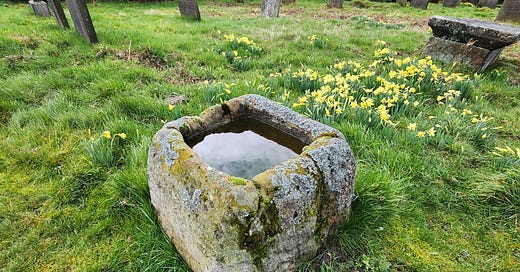Last week I showed you some of best examples of surviving and standing Anglo-Saxon crosses from the 7th - 10th centuries. This week we’re looking at the bits of them that survive.
Often all we have is a base. Here is a cross base from outside the church of St Mary in Stainburn. The current church is Norman (12th century) but it undoubtedly had a Saxon forebear, and in the churchyard, unnoticed by most, is this cross base:
You see quite a lot of these lying around churchyards. Judging by the erosion on this, it’s ancient and most likely held a cross 1000 years ago. If you factor in that every church would have had at least one cross nearby, there must have been hundreds of them scattered across the country. What happened to them all?
The answer seems to be a combination of natural damage, war and vandalism. Stone cracks - if water gets in and freezes, it can amplify natural cracks and shatter the stone. Some of the crosses, such as at Bewcastle and Hexham, have been in war zones; first the Vikings, during the 9th and 10th centuries, then later the Scottish border skirmishes. Finally it seems obvious that some succumbed during the post-Reformation period of the 16th century.
It was quite common in the 16th century for artefacts to be buried to protect them from damage by the puritanical Reformers. Sometimes they went under floors, sometimes walled up in doorways, or built into walls and other times buried in the churchyards.
In the early 11th century there was quite a fashion for tower building and a number of them incorporated bits of crosses in their construction. If the head of a cross survived, it was perfect for placement on the tower.
Keep reading with a 7-day free trial
Subscribe to Incola ego sum in terra to keep reading this post and get 7 days of free access to the full post archives.





